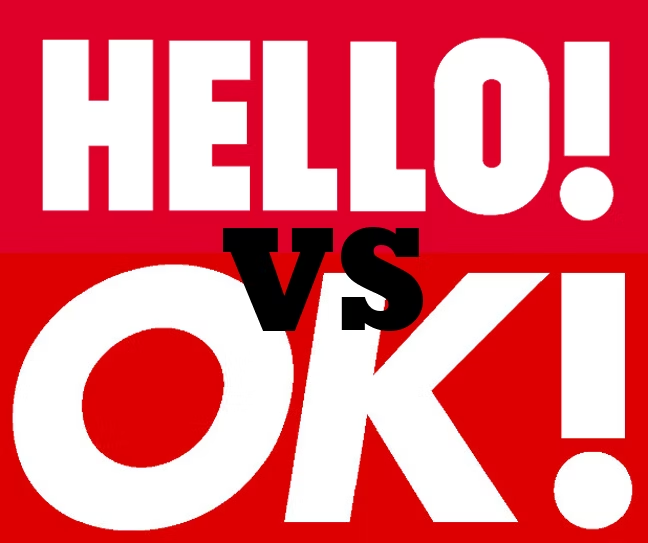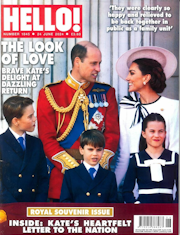
HELLO! and OK! are two of the best-selling magazines, both here on magazine.co.uk and across the country.
At first glance they seem pretty similar. They both have red logos. They’re both exclamations! And their front covers are both plastered with famous faces and sensationally shocking headlines.
So are there really that many differences? How’s a guy or gal supposed to choose between the two?
We got a hold of the first weekly June 2015 editions of both magazines and scoured the contents tooth and nail to get a better idea of what sets these two gossip giants apart.
HELLO! magazine and OK! magazine – The Back Stories

HELLO! is the British spin-off of the successful Spanish magazine, ¡HOLA! (translation: HELLO!) which was launched by husband and wife Antonio Sánchez Gómez and Mercedes Junco Calderón way back in 1944.
The British remake came to the UK in 1988. It’s been a big hit with the British public, leading to further exports — it’s now distributed in over 100 countries, with 23 different print editions and 9 different websites.
The publication sells itself as being much more positive than many glossy mags, focussing more on human interest stories like weddings, births, success stories and big celebrity events. Eduardo Sánchez Junco, who first brought HELLO! to the UK said:
“HELLO! exists to entertain and inform its readers... it does not sit in judgement on those it writes about. Its readers are quite capable of forming their own opinions.”

OK! magazine is British born and bred, owned by Northern & Shell, who also publish the Star and the Express tabloid newspapers.
The company launched OK! in 1993 and gained notoriety throughout the 90s with iconic covers such as the Beckhams' wedding, Michael Jackson’s baby pictures and Diana’s funeral. The brand now has more than 30 million readers worldwide, appearing in 23 countries, including Indonesia, Latvia and Venezuela.
Being the child of a successful tabloid publisher, OK! is more ruthless than its more sombre rival, HELLO! Its coverage focuses mainly on fashion, beauty and celebrity gossip, but also includes “real” stories about non-celebs.
What’s covered?
So what’s actually inside these magazines? Analysing the respective June 1 and 2 editions of HELLO! and OK! dredged up some interesting differences and similarities.

At first glance, it looks from the covers that the two magazines are covering pretty similar ground. Celebrity couples feature as the headline acts, wee Prince George just squeezing in to one corner of HELLO!'s cover.
Both magazines have a face value of £2 and are 116 pages, including the inside covers. We managed to group the content into nine separate categories.
Here’s the breakdown of what he found in HELLO!:
- Ads - 16 pages
- Beauty/Fashion - 30 pages
- Celebs - 40 pages
- Royals - 16 pages
- Wellbeing - 1 page
- Food - 3 pages
- News - 3 pages
- Misc - 1 page
And here’s what we found in OK!:
- Ads - 32 pages
- Beauty/Fashion - 16 pages
- Celebs - 45 pages
- Royals - 1 page
- Wellbeing - 2 pages
- Food - 2 pages
- Real People - 2 pages
- Misc - 2 pages
As expected, celebrity features filled the most pages in both mags, although OK! featured a few more pages. There were a few story crossovers, including Geri Halliwell's honeymoon and the story of Prince William awarding actress Sheridan Smith her OBE.
At first glance I thought it strange that both magazines featured the exact same recipe for a new potato and chorizo tortilla. But on closer inspection it was clearly an advertorial for a new Raymond Blanc book.
The biggest difference between the two mags is that HELLO! is much more royalist — I guess we’d expect that from the tagline “Best for babies, weddings and royals.” A pretty substantial 16% of this issue is taken up with Royal stories, compared to a single page in OK!.
Who’s reading?
OK! definitely seems more accessible, on the whole. Whereas HELLO! focusses on aristocrats and Hollywood superstars, OK! takes a more grounded approach, featuring more home-grown stars from British soaps and reality TV shows.
We obviously can’t reveal who’s subscribing to these titles through magazine.co.uk, but we can tell you that both magazines are very popular in cities, with OK! picking up a few more urban subscribers. However, HELLO! holds its own in more rural areas like Cornwall and the Scottish Highlands. This probably has something to do with how rural areas are more traditional and so more likely to be drawn towards HELLO!’s aspirational content.
So, there you have it, our dissection is complete. Whichever mag takes your fancy, you can save money by subscribing to HELLO! or OK! through magazine.co.uk.






